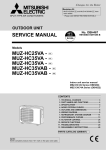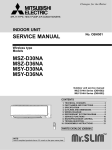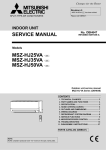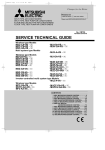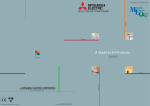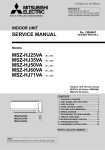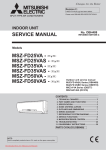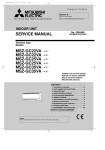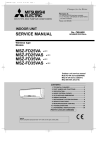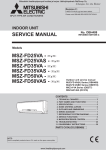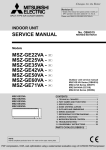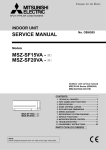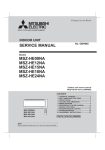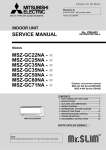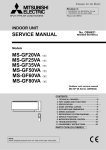Download Mitsubishi MSZ-HC35VA Service manual
Transcript
Revision B: • MSZ-HC35VA- E2 and MSZ-HC35VABhave been added. E2 Please void OBH466 REVISED EDITION-A. SPLIT-TYPE AIR CONDITIONERS INDOOR UNIT SERVICE MANUAL No. OBH466 REVISED EDITION-B Models MSZ-HC25VA MSZ-HC35VA MSZ-HC35VA MSZ-HC35VAB MSZ-HC35VAB - E1 E1 E2 E1 E2 Outdoor unit service manual MUZ-HC·VA Series (OBH467) CONTENTS 1. TECHNICAL CHANGES ··································· 3 2. PART NAMES AND FUNCTIONS ····················· 4 3. SPECIFICATION ················································ 5 4. NOISE CRITERIA CURVES ······························ 6 5. OUTLINES AND DIMENSIONS ························ 7 6. WIRING DIAGRAM············································ 7 7. REFRIGERANT SYSTEM DIAGRAM ··············· 9 8. SERVICE FUNCTIONS ··································· 10 9. MICROPROCESSOR CONTROL ··················· 12 10. TROUBLESHOOTING ····································· 17 11. DISASSEMBLY INSTRUCTIONS ···················· 29 PARTS CATALOG (OBB466) NOTE: RoHS compliant products have <G> mark on the spec name plate. Revision A: • 10. TROUBLESHOOTING has been corrected. • Color of lead wire (indoor fan motor : sensor part) of 10-5. ”Trouble criterion of main parts” has been corrected. • 10-6.” Check of indoor fan motor” has been corrected. [MSZ-HC25] Revision B: • MSZ-HC35VA- E2 and MSZ-HC35VAB- E2 have been added. Indoor coil thermistor (RT13) has been added. 2 1 TECHNICAL CHANGES MSZ-HA25VA MSZ-HA35VA MSZ-HA35VA - E1 E1 E1 → MSZ-HC25VA - E1 → MSZ-HC35VA - E1 → MSZ-HC35VAB - E1 1. Indoor fan motor has been changed. (DC AC) [MSZ-HC25] 2. Indoor heat exchanger has been changed. [MSZ-HC35] 3. Indoor electronic control P.C. board has been changed. MSZ-HC35VA - E1 → MSZ-HC35VA - E2 MSZ-HC35VAB - E1 → MSZ-HC35VAB - E2 1. Wiring diagram has been changed. 3 2 PART NAMES AND FUNCTIONS MSZ-HC25VA MSZ-HC35VA MSZ-HC35VAB Air inlet Front panel Air filter (Anti-mold) Air outlet Remote controller Vertical vane Horizontal vane Remote control receiving section Emergency operation switch (E.O. SW) Operation Indicator lamp ACCESSORIES Installation plate Installation plate fixing screw 4 × 25 mm Battery (AAA) for remote controller Wireless remote controller Felt tape (Used for left or left-rear piping) 1 5 2 1 1 4 3 SPECIFICATION Special remarks Indoor model MSZ-HC25VA MSZ-HC35VA MSZ-HC35VAB Function Cooling Heating Cooling Heating Cooling Heating Power supply Single phase, 230 V, 50 Hz A 0.22 Electrical Running current 1 data Power input 1 W 40 23 Model RC4V18-BA or CA RC0J40-ED Fan motor Current 1 A 0.22 Dimensions W × H × D mm 788×295×225 Weight kg 9 (Super High) 630 546 612 552 612 552 3 Air flow m /h (High/Med./Low) 522/420/318 468/390/306 504/408/312 480/402/294 504/408/312 480/402/294 Air direction 4 43 Sound (Super High) dB(A) level (High/Med./Low) 38/32/26 (Super High) 1,110 980 1,140 1,050 1,140 1,050 Fan rpm speed (High/Med./Low) 950/800/650 870/750/630 980/830/680 940/820/660 980/830/680 940/820/660 Fan speed regulator 4 Remote controller model MP06B NOTE : Test conditions are based on ISO 5151. Cooling : Indoor Dry-bulb temperature 27°C Outdoor Dry-bulb temperature 35°C Heating : Indoor Dry-bulb temperature 20°C Outdoor Dry-bulb temperature 7°C Refrigerant piping length (one way) : 5 m 1 Measured under rated operating frequency. Wet-bulb temperature 19°C Wet-bulb temperature 6°C Specifications and rating conditions of main electric parts Fuse Horizontal vane motor Varistor Terminal block (F11) (MV) (NR11) (TB) T3.15AL250V 12 VDC S10K320E3K1 (ERZV14D471) 3P 5 4 NOISE CRITERIA CURVES MSZ-HC25VA MSZ-HC35VA MSZ-HC35VAB FAN SPEED FUNCTION Super High SPL(dB(A)) COOLING 43 HEATING 43 FAN SPEED FUNCTION LINE Super High OCTAVE BAND SOUND PRESSURE LEVEL, dB re 0.0002 MICRO BAR OCTAVE BAND SOUND PRESSURE LEVEL, dB re 0.0002 MICRO BAR 80 70 NC-70 60 NC-60 50 NC-50 40 NC-40 30 NC-30 10 43 HEATING 43 LINE 90 90 20 SPL(dB(A)) COOLING APPROXIMATE THRESHOLD OF HEARING FOR CONTINUOUS NOISE 63 125 NC-20 80 70 60 NC-60 50 NC-50 40 NC-40 30 NC-30 20 10 250 500 1000 2000 4000 8000 NC-70 APPROXIMATE THRESHOLD OF HEARING FOR CONTINUOUS NOISE 63 125 NC-20 250 500 1000 2000 4000 8000 BAND CENTER FREQUENCIES, Hz BAND CENTER FREQUENCIES, Hz Test conditions Cooling : Dry-bulb temperature 27°C Wet-bulb temperature 19°C Heating : Dry-bulb temperature 20°C INDOOR UNIT WALL 1m 0.8m MICROPHONE 6 5 OUTLINES AND DIMENSIONS MSZ-HC25VA MSZ-HC35VA MSZ-HC35VAB Unit : mm 225 11 × 20 Oblong hole 59 225 18.5 11 × 26 Oblong hole 59 Installation plate 155 335 Indoor unit 5 235 253.5 214 155 59 320 74 Wall hole ø65 Air in 225 2 41.5 40.5 254.5 215 788 Installation plate 42 53 Air out 50 WIRING DIAGRAM MSZ-HC25VA 7 Insulation Liquid line Gas line Drain hose Piping 42 42 58 6 128 Drain hose 119 137 18 140 57 607 42 57 100 8 58 295 Piping ø35 O.D ø6.35 - 0.5 m (Flared connection ø6.35) ø9.52 - 0.43 m (Flared connection ø9.52) Insulation ø28 O.D Connected part ø16 O.D MSZ-HC35VA- E1 MSZ-HC35VAB- E1 MSZ-HC35VA- E2 MSZ-HC35VAB- E2 8 7 REFRIGERANT SYSTEM DIAGRAM MSZ-HC25VA MSZ-HC35VA- E1 MSZ-HC35VAB- E1 Unit : mm Refrigerant pipe ø9.52 (with heat insulator) Indoor heat exchanger Indoor coil thermistor RT12 Flared connection Room temperature thermistor RT11 Flared connection Refrigerant pipe ø6.35 (with heat insulator) Refrigerant flow in cooling Refrigerant flow in heating MSZ-HC35VA- E2 MSZ-HC35VAB- E2 Refrigerant pipe ø9.52 (with heat insulator) Indoor heat exchanger Indoor coil thermistor RT12 Flared connection Indoor coil thermistor RT13 Room temperature thermistor RT11 Flared connection Refrigerant pipe ø6.35 (with heat insulator) Refrigerant flow in cooling Refrigerant flow in heating 9 8 SERVICE FUNCTIONS MSZ-HC25VA MSZ-HC35VA MSZ-HC35VAB 8-1. TIMER SHORT MODE For service, set time can be shortened by short circuit of JPG and JPS on the electronic control P.C. board. The time will be shortened as follows. (Refer to 10-7.) Set time : 1-minute → 1-second Set time : 3-minute → 3-second (It takes 3 minutes for the compressor to start operation. However, the starting time is shortened by short-circuit of JPG and JPS.) 8-2. P.C. BOARD MODIFICATION FOR INDIVIDUAL OPERATION A maximum of 4 indoor units with wireless remote controllers can be used in a room. In this case, to operate each indoor unit individually by each remote controller, P.C. boards of remote controller must be modified according to the number of the indoor unit. How to modify the remote controller P.C. board Remove batteries before modification. The board has a print as shown below : J1 J2 NOTE : For modification, take out the batteries and press the OPERATE/STOP (ON/ OFF) button twice or 3 times at first. After finish modification, put back the batteries then press the RESET button. The P.C. board has the print “J1” and “J2”. Solder “J1” and “J2” according to the number of indoor unit as shown in Table 1. After modification, press the RESET button. Table 1 1 unit operation 2 units operation 3 units operation 4 units operation No. 1 unit No modification Same as at left Same as at left Same as at left No. 2 unit – Solder J1 Same as at left Same as at left No. 3 unit – – Solder J2 Same as at left No. 4 unit – – – Solder both J1 and J2 How to set the remote controller exclusively for particular indoor unit After you turn the breaker ON, the first remote controller that sends the signal to the indoor unit will be regarded as the remote controller for the indoor unit. The indoor unit will only accept the signal from the remote controller that has been assigned to the indoor unit once they are set. The setting will be cancelled if the breaker has turned OFF, or the power supply has shut down. Please conduct the above setting once again after the power has restored. 10 8-3. AUTO RESTART FUNCTION When the indoor unit is controlled with the remote controller, the operation mode, the set temperature, and the fan speed are memorized by the indoor electronic control P.C. board. “AUTO RESTART FUNCTION” automatically starts operation in the same mode just before the shutoff of the main power. Operation If the main power has been cut, the operation settings remain. After the power is restored, the unit restarts automatically according to the memory. (However, it takes at least 3 minutes for the compressor to start running.) How to release “AUTO RESTART FUNCTION” CN10A CN151 Indoor electronic control P.C. board CN112 CN111 Turn off the main power for the unit. Solder the Jumper wire to JR07 on the indoor electronic control P.C. board. (Refer to 10-7.) JR07 NOTE: • The operation settings are memorized when 10 seconds have passed after the indoor unit was operated with the remote controller. • If main power is turned OFF or a power failure occurs while AUTO START/STOP timer is active, the timer setting is cancelled. • If the unit has been off with the remote controller before power failure, the auto restart function does not work as the power button of the remote controller is off. • To prevent breaker OFF due to the rush of starting current, systematize other home appliance not to turn ON at the same time. • When some air conditioners are connected to the same supply system, if they are operated before power failure, the starting current of all the compressors may flow simultaneously at restart. Therefore, the special counter measures are required to prevent the main voltage-drop or the rush of the starting current by adding to the system that allows the units to start one by one. 11 9 MICROPROCESSOR CONTROL MSZ-HC25VA MSZ-HC35VA MSZ-HC35VAB WIRELESS REMOTE CONTROLLER Signal transmitting section Operation display section ON/OFF (operate/stop) button Temperature buttons Fan speed control button ECONO COOL button Vane control button Operation select button Timer mode select button Time set buttons RESET button NOTE : Last setting will be stored after the unit is turned OFF with the remote controller. Indoor unit receives the signal of the remote controller with beeps. INDOOR UNIT DISPLAY SECTION Operation Indicator lamp The operation indicator at the right side of the indoor unit indicates the operation state. • The following indication applies regardless of shape of shape of the indication. Indication Operation state Room temperature Lighted Blinking The unit is operating to reach the set temperature About 2°C or more away from set temperature The room temperature is approaching the set temperature About 1 to 2°C from set temperature 12 Not lighted 9-1. COOL ( ) OPERATION (1) Press OPERATE/STOP (ON/OFF) button. OPERATION INDICATOR lamp of the indoor unit turns on with a beep tone. (2) Select COOL mode with OPERATION SELECT button. (3) Press TEMPERATURE buttons (TOO WARM or TOO COOL button) to select the desired temperature. The setting range is 16 ~ 31°C. 1. Coil frost prevention The compressor operational frequency is controlled by the temperature of the indoor heat exchanger to prevent the coil from frosting. When the temperature of indoor heat exchanger becomes too low, the coil frost prevention mode works. The indoor fan operates at the set speed and the compressor stops. This mode continues until the temperature of indoor heat exchanger rises. 9-2. DRY ( ) OPERATION (1) Press OPERATE/STOP (ON/OFF) button. OPERATION INDICATOR lamp of the indoor unit turns on with a beep tone. (2) Select DRY mode with OPERATION SELECT button. (3) The set temperature is determined from the initial room temperature. 1. Coil frost prevention Coil frost prevention is as same as COOL mode. (9-1.1.) 9-3. HEAT ( ) OPERATION (1) Press OPERATE/STOP (ON/OFF) button. OPERATION INDICATOR lamp of the indoor unit turns on with a beep tone. (2) Select HEAT mode with OPERATION SELECT button. (3) Press TEMPERATURE buttons (TOO WARM or TOO COOL button) to select the desired temperature. The setting range is 16 ~ 31°C. 1. Cold air prevention control When the compressor is not operating or is starting, and the temperature of indoor heat exchanger and/or the room temperature is low or when defrosting is being done, the indoor fan will stop or rotate in Very Low speed. 2. High pressure protection The compressor operational frequency is controlled by the temperature of the indoor heat exchanger to prevent the condensing pressure from increasing excessively. When the temperature of indoor heat exchanger becomes too high, the high pressure protection works. The indoor fan operates following the cold air prevention control. This mode continues until the temperature of indoor heat exchanger falls. 3. Defrosting Defrosting starts when the temperature of outdoor heat exchanger becomes too low. The compressor stops once, the indoor/outdoor fans stop, the 4-way valve reverses, and the compressor re-starts. This mode continues until the temperature of outdoor heat exchanger rises or the fixed time passes. 13 9-4. AUTO VANE OPERATION 1. Horizontal vane (1) Vane motor drive These models are equipped with a stepping motor for the horizontal vane. The rotating direction, speed, and angle of the motor are controlled by pulse signals (approx. 12 V) transmitted from indoor microprocessor. (2) The horizontal vane angle and mode change as follows by pressing VANE CONTROL button. AUTO 1 2 3 4 SWING (3) Positioning To confirm the standard position, the vane moves until it touches the vane stopper. Then the vane is set to the selected angle. Confirming of standard position is performed in the following cases: (a) When the operation starts or finishes (including timer operation). (b) When the test run starts. (4) VANE AUTO ( ) mode In VANE AUTO mode, the microprocessor automatically determines the vane angle to make the optimum room temperature distribution. In COOL and DRY operation Vane angle is fixed to Horizontal position. In HEAT operation Vane angle is fixed to Angle 4. Horizontal position (5) STOP (operation OFF) and ON TIMER standby In the following cases, the horizontal vane returns to the closed position. (a) When OPERATE/STOP (ON/OFF) button is pressed (POWER OFF). (b) When the operation is stopped by the emergency operation. (c) When ON TIMER is ON standby. (6) Dew prevention During COOL or DRY operation with the vane angle at Angle 2 ~ 4 when the compressor cumulative operation time exceeds 1 hour, the vane angle automatically changes to Angle 1 for dew prevention. (7) SWING ( ) mode By selecting SWING mode with VANE CONTROL button, the horizontal vane swings vertically. (8) Cold air prevention in HEAT operation. The horizontal vane position is set to Upward. 14 (9) To change the airflow direction not to blow directly onto your body. When to use this function? Pressing and holding Use this function if VANE CONTROL button you don’t want the air for 2 seconds or more from the indoor unit to cause the horizontal vane blow directly onto your to reverse and move to body. horizontal position. • Depending on the shape of the room, the air may blow directly onto your body. Horizontal • Press VANE CONposition TROL button again to return the vane to the previously-set position. To change the airflow direction COOL/DRY HEAT The air conditioner starts the cooling or drying operation approx. 3 minutes after the vane has moved to the horizontal position. • When VANE CONTROL button is pressed again, the vane returns to the previously-set position and the air conditioner starts the cool or dry operation in approx. 3 minutes. The air conditioner starts heating operation approx. 3 minutes after the vane has moved to the horizontal position. • Sometimes the area around your feet may not warm. To warm the area around the feet, set the hori(AUTO) or the zontal vane to downward-blowing position. • When VANE CONTROL button is pressed again, the vane returns to the previously-set position and the air conditioner starts the heat operation in approx. 3 minutes. NOTE : • If you make the airflow not to blow directly onto your body by pressing VANE CONTROL button, the compressor stops for 3 minutes even during the operation of the air conditioner. • The air conditioner operates with Very Low speed until the compressor turns on again. (10) ECONO COOL ( ) operation (ECONOmical operation) When ECONO COOL button is pressed in COOL mode, set temperature is automatically set 2°C higher. Also the horizontal vane swings in various cycle. SWING operation makes you feel cooler than set temperature. So, even though the set temperature is higher, the air conditioner can keep comfort. As a result, energy can be saved. ECONO COOL operation is cancelled when ECONO COOL button is pressed once again or VANE CONTROL button is pressed or change to other operation mode. 15 9-5. TIMER OPERATION (ON/OFF TIMER) 1. How to set the timer (1) Press OPERATE/STOP (ON/OFF) button to start the air conditioner. (2) Select the timer mode by pressing the button during operation. Each time this button is pressed, the timer mode is changed in sequence: (OFF TIMER) → (ON TIMER) → TIMER RELEASE (3) Set the time of the timer using the button. Each time this button is pressed, the set time increase or decrease by 1 hour to 12 hours. 2. To release the timer Press the button until (OFF TIMER) and (ON TIMER) are not displayed. NOTE : • The OFF TIMER and the ON TIMER cannot be set at the same time. • The displayed time is the time remaining and will decrease in 1-hour increments as time passes. 9-6. EMERGENCY/TEST OPERATION In case of test run operation or emergency operation, use EMERGENCY OPERATION switch on the right side of the indoor unit. Emergency operation is available when the remote controller is missing, has failed or the batteries of the remote controller run down. The unit will start and OPERATION INDICATOR lamp will light. The first 30 minutes of operation is the test run operation. This operation is for servicing. The indoor fan runs at High speed and the system is in continuous operation (The thermostat does not work). After 30 minutes of test run operation, the system shifts to EMERGENCY COOL/HEAT MODE with a set temperature of 24°C. The fan speed shifts to Med.. In the test run or emergency operation, the horizontal vane operates in VANE AUTO ( ) mode. Emergency operation continues until EMERGENCY OPERATION switch is pressed once or twice or the unit receives any signal from the remote controller. In case of latter, normal operation will start. NOTE : Do not press EMERGENCY OPERATION switch during normal operation. Operation mode Set temperature Fan speed Horizontal vane COOL 24°C Med. Auto HEAT 24°C Med. Auto The operation mode is indicated by the Operation Indicator lamp as following Operation Indicator lamp EMERGENCY OPERATION switch EMERGENCY COOL ↓ EMERGENCY HEAT Lighted Not lighted ↓ STOP 9-7. 3-MINUTE TIME DELAY OPERATION When the system turns OFF, compressor will not restart for 3 minutes as 3-minute time delay function operates to protect compressor from overload. 16 10 TROUBLESHOOTING MSZ-HC25VA MSZ-HC35VA MSZ-HC35VAB 10-1. CAUTIONS ON TROUBLESHOOTING 1. Before troubleshooting, check the following: 1) Check the power supply voltage. 2) Check the indoor/outdoor connecting wire for miswiring. 2. Take care of the following during servicing 1) Before servicing the air conditioner, be sure to turn OFF the main unit first with the remote controller, and then after confirming the horizontal vane is closed, turn OFF the breaker and/or disconnect the power plug. 2) Be sure to turn OFF the power supply before removing the front panel, the cabinet, the top panel, and the P.C. board. 3) When removing the P.C. board, hold the edge of the board with care NOT to apply stress on the components. 4) When connecting or disconnecting the connectors, hold the housing of the connector. DO NOT pull the lead wires. Lead wiring Housing point 3. Troubleshooting procedure 1) First, check if the OPERATION INDICATOR lamp on the indoor unit is flashing on and off to indicate an abnormality. To make sure, check how many times the abnormality indication is flashing on and off before starting service work. 2) Before servicing check that the connector and terminal are connected properly. 3) If the P.C. board is supposed to be defective, check the copper foil pattern for disconnection and the components for bursting and discoloration. 4) When troubleshooting, refer to 10-2., 10-3. and 10-4. 4. How to replace batteries Weak batteries may cause the remote controller malfunction. In this case, replace the batteries to operate the remote controller normally. Press RESET button with a thin instrument, and then use the remote controller. Remove the back lid and insert batteries. Then reattach the back lid. Insert the minus pole of the batteries first. Check if the polarity of the batteries is correct. NOTE : 1. If RESET button is not pressed, the remote controller may not operate correctly. 2. This remote controller has a circuit to automatically reset the microcomputer when batteries are replaced. This function is equipped to prevent the microcomputer from malfunctioning due to the voltage drop caused by the battery replacement. 17 10-2. FAILURE MODE RECALL FUNCTION Outline of the function This air conditioner can memorize the abnormal condition which has occurred once. Even though LED indication listed on the troubleshooting check table (10-4.) disappears, the memorized failure details can be recalled. This mode is very useful when the unit needs to be repaired for the abnormality which doesn't recur. 1. Flow chart of failure mode recall function for the indoor/outdoor unit Operational procedure The cause of abnormality cannot be found because the abnormality doesn't recur. Setting up the failure mode recall function Turn ON the power supply. <Preparation of the remote controller> While pressing both OPERATION SELECT button and TOO COOL button on the remote controller at the same time, press RESET button. First, release RESET button. And release the other two buttons after all LCD in operation display section of the remote controller is displayed after 3 seconds. Press OPERATE/STOP (ON/OFF) button of the remote controller (the set temperature is displayed) with the remote controller headed towards the indoor unit. 1 Does upper lamp of OPERATION INDICATOR lamp on the indoor unit blink at the interval of 0.5 seconds? Blinks: Either indoor or outdoor unit is abnormal. Beep is emitted at the same timing as the blinking of upper lamp of OPERATION INDICATOR lamp. 2 Yes (Blinks) Judgment of indoor/outdoor abnormality Before blinking, does upper lamp of OPERATION INDICATOR lamp stay ON for 3 seconds? Yes Stays ON for 3 seconds (without beep): The outdoor unit is abnormal. No 1. Regardless of normal or abnormal condition, a short beep is emitted once the signal is received. Indoor unit is normal. But the outdoor unit might be abnormal because there are some abnormalities that can't be recalled with this way. Confirm if outdoor unit is abnormal according to the detailed outdoor unit failure mode recall function. No (OFF) The indoor unit is abnormal. Check the blinking pattern, and confirm the abnormal point with the indoor unit failure mode table. (Refer to 10-2.2) Make sure to check at least two consecutive blinking cycles. 2 The outdoor unit is abnormal. Check the blinking pattern, and confirm the abnormal point with the outdoor unit failure mode table. (Refer to outdoor unit service manual.) Make sure to check at least two consecutive blinking cycles. 3 Releasing the failure mode recall function Release the failure mode recall function by the following procedures. Turn OFF the power supply and turn it ON again. Press RESET button of the remote controller. Repair the defective parts. Deleting the memorized abnormal condition After repairing the unit, recall the failure mode again according to "Setting up the failure mode recall function" mentioned above. Press OPERATE/STOP (ON/OFF) button of the remote controller (the set temperature is displayed) with the remote controller headed towards the indoor unit. Press EMERGENCY OPERATION switch so that the memorized abnormal condition is deleted. Release the failure mode recall function according to "Releasing the failure mode recall function" mentioned above. NOTE: 1. Make sure to release the failure mode recall function once it's set up, otherwise the unit cannot operate properly. 2. If the abnormal condition is not deleted from the memory, the last abnormal condition is kept memorized. 2. Blinking pattern when the indoor unit is abnormal: Blinking at 0.52.5-second OFF second interval Blinking at 0.52.5-second OFF second interval ON OFF Beeps Repeated cycle Beeps Repeated cycle 3.Blinking pattern when the outdoor unit is abnormal: Blinking at 0.52.5-second OFF 3-second ON second interval Beeps Repeated cycle 2.5-second OFF 3-second ON Blinking at 0.5second interval ON OFF No beep Repeated cycle No beep Repeated cycle Beeps 18 Beeps Repeated cycle 2. Indoor unit failure mode table Upper lamp of OPAbnormal point ERATION INDICA(Failure mode) TOR lamp Not lighted Normal Condition Correspondence — The room temperature thermistor short or 1-time flash every Room temperature open circuit is detected every 8 seconds dur0.5-second thermistor ing operation. Indoor coil 2-time flash The indoor coil thermistor short or open circuit 2.5-second OFF is detected every 8 seconds during operation. thermistor 3-time flash The serial signal from outdoor unit is not reSerial signal 2.5-second OFF ceived for a maximum of 6 minutes. The rotational frequency feedback signal is 11-time flash Indoor fan motor not emit during the 12 seconds the indoor fan 2.5-second OFF operation. It cannot properly read data in the nonvolatile 12-time flash Indoor control memory of the indoor electronic control P.C. 2.5-second OFF system board. — Refer to the characteristics of the room temperature thermistor (10-7.). Refer to the characteristics of the main indoor coil thermistor, the sub indoor coil thermistor (10-7.). Refer to 10-6. "How to check miswiring and serial signal error". Refer to 10-6. "Check of indoor fan motor". Replace the indoor electronic control P.C. board. NOTE : Blinking patterns of this mode differ from the ones of TROUBLESHOOTING CHECK TABLE (10-4.). 19 10-3. INSTRUCTION OF TROUBLESHOOTING Start Indoor unit operates. Outdoor unit doesn't operate. Outdoor unit operates only in Test Run operation. Check room temperature thermistor. Refer to 10-7. "Test point diagram and voltage". Outdoor unit doesn't operate even in Test Run operation. Refer to "How to check inverter/compressor". Indoor unit operates. Outdoor unit doesn't operate normally. Unit doesn't operate normal operation in COOL or HEAT mode. Refer to "Check of R.V. coil". Indoor unit doesn't receive the signal from remote controller. Indoor unit operates, when EMERGENCY OPERATION switch is pressed. Refer to 10-6. "Check of remote controller and indoor electronic control P.C. board". OPERATION INDICATOR lamp on the indoor unit is flashing on and off. If blinking of OPERATION INDICATOR lamp cannot be checked, it can be checked with failure mode recall function. Indoor unit doesn't operate, when EMERGENCY OPERATION switch is pressed. 1. Check indoor/outdoor connecting wire. (Check if the power is supplied to the indoor unit.) 2. Refer to 10-6. "Check of indoor P.C. board and indoor fan motor". "Test Run operation" means the operation within 30 minutes after EMERGENCY OPERATION switch is pressed. Refer to outdoor unit service manual. Upper lamp Flash on and off at 0.5-second intervals Cause: Indoor/Outdoor unit • Miswiring or trouble of serial signal Upper lamp 2-time flash Cause: Indoor unit • Trouble of room temperature / indoor coil thermistor Upper lamp 3-time flash Cause: Indoor unit • Trouble of indoor fan motor Upper lamp 4-time flash Cause: Indoor unit • Trouble of indoor unit control system Upper lamp 5-time flash Cause: Outdoor unit • Outdoor power system abnormality Upper lamp 6-time flash Cause: Outdoor unit • Trouble of thermistor in outdoor unit Upper lamp 7-time flash Cause: Outdoor unit • Trouble of outdoor control system Upper lamp 14-time flash Cause: Outdoor unit • Other abnormality Refer to 10-6. "How to check miswiring and serial signal error". Check room temperature thermistor and indoor coil thermistor. Refer to 10-7."Test point diagram and voltage". Refer to 10-6. "Check of indoor fan motor". Replace the indoor electronic control P.C. board. Refer to "How to check inverter/compressor". Refer to "Check of outdoor thermistors". Replace the inverter P.C. board or the outdoor electronic control P.C. board. Check "Flow chart of the detailed outdoor unit failure mode recall function." 20 10-4. TROUBLESHOOTING CHECK TABLE Before taking measures, make sure that the symptom reappears for accurate troubleshooting. When the indoor unit has started operation and detected an abnormality of the following condition (the first detection after the power ON), the indoor fan motor turns OFF and OPERATION INDICATOR lamp flashes. OPERATION INDICATOR Lighted Blinking Not lighted No. 1 Abnormal point Miswiring or serial signal Indoor coil thermistor 2 Room temperature thermistor Operation indicator lamp Symptom Condition Upper lamp flashes. 0.5-second ON The serial signal from the outdoor unit is not received for 6 minutes. 0.5-second OFF Upper lamp flashes. 2-time flash Correspondence • Refer to 10-6. "How to check miswiring and serial signal error". The indoor coil or the room temperature thermistor is short or open circuit. • Refer to 10-7. the characteristics of indoor coil thermistor, and the room temperature thermistor. The rotational frequency feedback signal is not emitted during the indoor fan operation. • Refer to 10-6. "Check of indoor fan motor". It cannot properly read data in the nonvolatile memory of the indoor electronic control P.C. board. • Replace the indoor electronic control P.C. board. 2.5-second OFF Upper lamp flashes. 3-time flash 3 Indoor fan motor 2.5-second OFF Upper lamp flashes. 4-time flash 4 Indoor control system 2.5-second OFF 5 Outdoor power system Upper lamp flashes. 5-time flash Indoor unit and outdoor unit do not operate. 2.5-second OFF • Refer to "How to check of inIt consecutively occurs 3 times that the comverter/compressor". pressor stops for overcurrent protection or Refer to outdoor unit service start-up failure protection within 1 minute after manual start-up. • Check the stop valve. Upper lamp flashes. 6-time flash 6 Outdoor thermistors The outdoor thermistors short or open circuit during the compressor operation. • Refer to "Check of outdoor thermistor". Refer to outdoor unit service manual. It cannot properly read data in the nonvolatile memory of the inverter P.C. board or the outdoor electronic control P.C. board. • Replace the inverter P.C. board or the outdoor electronic control P.C. board. Refer to outdoor unit service manual. An abnormality other than above mentioned is detected. • Check the stop valve. • Confirm the abnormality in detail using the failure mode recall function for outdoor unit. It cannot properly read data in the nonvolatile memory of the inverter P.C. board or the outdoor electronic control P.C. board. • Check the blinking pattern of the LED on the inverter P.C. board or the outdoor electronic control P.C. board. 2.5-second OFF 7 Outdoor control system Upper lamp flashes. 7-time flash 2.5-second OFF Upper lamp flashes. 14-time flash 8 Other abnormality 2.5-second OFF 9 Outdoor control sys- Upper lamp lights up tem Outdoor unit does not operate 21 10-5. TROUBLE CRITERION OF MAIN PARTS MSZ-HC25VA MSZ-HC35VA MSZ-HC35VAB Part name Room temperature thermistor (RT11) Check method and criterion Measure the resistance with a tester. Figure Indoor fan motor (MF) MSZ-HC35 Measure the resistance between the terminals with a tester. (Part temperature 10 ~ 30°C) Normal RC4V18-BA RC4V18-CA 273 ~ 296 Ω 308 ~ 334 Ω 295 ~ 320 Ω 295 ~ 320 Ω Color of lead wire WHT - BLK BLK - RED MAIN AUX. FUSE Normal range 4.5 ~ 5.5 V BRN - GRY (When fan revolved one time) 0V 5V 0V (Approx.) WHT Color of lead wire BRN - YLW BLK BRN YLW GRY RED Measure the voltage power ON. Sensor part Indoor fan motor (MF) MSZ-HC25 INNER FUSE BA : 135 ± 3°C CUT OFF CA : 140 ± 2°C CUT OFF Motor part Refer to 10-7. "Test point diagram and voltage", "2. Indoor electronic control P.C. board", the chart of thermistor. Indoor coil thermistor (RT12, RT13) Check 10-6. . BLK Measure the resistance between the terminals with a tester. (Part temperature 10 ~ 30°C) Color of the lead wire Normal RED - BLK 235 ~ 255 Ω Vane motor (MV) ROTOR BLK RED BLK BLK 10-6. TROUBLESHOOTING FLOW A Check of indoor fan motor MSZ-HC25VA Turn OFF the power supply. Check connector CN211 visually. Reconnect the lead wires. No Are lead wires connected? Are soldered points of the connector correctly soldered to indoor power P.C. board? Yes Yes ( 0 or ) No (others) Turn ON the power supply. Rotate indoor fan slowly for 1 revolution or over with a screwdriver etc. from air outlet, and measure the voltage No.2(+) and No.1(-) on CN121. No Replace the indoor fan motor. Resolder it. Yes Disconnect the lead wires from connector CN211 on indoor power P.C. board. Measure the resistance between lead wires No.1 and No.4 and then No.4 and No.7. Is the resistance 0 (short circuit) or ∞ (open circuit)? No Does the voltage repeat 0 and 5 VDC? Yes Indoor terminal P.C.board Replace the indoor power P.C. board, the indoor terminal P.C. board and the indoor electronic control P.C. board. Indoor power P.C.board Fuse (F11) CN121 Varistor (NR11) CN211 22 MSZ-HC35VA MSZ-HC35VAB The indoor fan motor error has occurred, and the indoor fan doesn't operate. Turn OFF the power supply. Pay careful attention to the high voltage on the fan motor connector CN211. Is there any foreign matter that interferes the rotation of the line flow fan? Turn ON the power supply, wait 5 seconds or more, and then press EMERGENCY OPERATION switch. Measure the supply voltage as follows within 12 seconds after EMERGENCY OPERATION switch is pressed. If more than 12 seconds passes by, turn OFF the power supply and turn ON it again, then measure the voltage. <Indoor power P.C. board> 1. Measure the voltage between CN211 (+) and (–). 2. Measure the voltage between CN211 (+) and (–). <Indoor electronic control P.C. board> 1. Measure the voltage between CN10A (+) and JPG(GND)(–). No Yes Remove the foreign matter and adjust the line flow fan. Is there 325 VDC between CN211 (+) and (–) ? If more than 12 seconds passes after EMERGENCY OPERATION switch is pressed, the voltage mentioned above 2 goes 0 VDC although the indoor P.C. board is normal Does the voltage between CN211 (+) and (–) on the power P.C. board rise to the range of 2 to 6 VDC within 12 seconds after EMERGENCY OPERATION switch is pressed? Yes Replace the indoor fan motor. Yes No No Replace the indoor power P.C. board and the indoor terminal P.C. board. Yes Does the voltage between CN10A (+) and JPG (GND)(–) on the indoor electronic control P.C. board fall to 2 V or less within 12 seconds after EMERGENCY OPERATION switch is pressed? Replace the indoor electronic control P.C. board. No The indoor fan motor error has occurred, and the indoor fan repeats "12-second ON and 30-second OFF" 3 times, and then stops. Measure the voltage between CN211 (+) and (–) while the fan is rotating. Is it unchanged holding 0 or 15 VDC? Yes (Unchanged) Measure the voltage CN10A (+) and JPG (GND)(–) on the indoor No electronic control P.C board when (Changed) the fan is rotating. Replace the indoor fan motor. Replace the indoor power P.C. board and the indoor terminal P.C. board. Indoor electronic control P.C. board Yes (Unchanged) Is it unchanged holding 0 or 15 VDC? Indoor terminal P.C.board JPG (GND) Replace the indoor electronic control P.C. board. Indoor power P.C.board Fuse (F11) CN10A No (Changed) Varistor (NR11) 23 CN211 B Check of remote controller and indoor electronic control P.C. board Check if the remote controller is exclusive for this air conditioner. Press OPERATE/STOP (ON/OFF) button on the remote controller. Is LCD display on the remote controller visible? Yes No (Not clear) Replace the batteries. (Refer to 10-1.4.) Remove the batteries, then set them back and press RESET button. (Refer to 10-1.4.) Check if the unit operates with the remote controller. Does the unit operate with the remote controller? No Turn ON a radio to AM and press OPERATE/STOP (ON/OFF) button on the remote controller. Yes OK Is noise heard from radio? No Replace the remote controller. Yes Are there any fluorescent lights of inverter or rapid-start type within the range of 1 m? No Replace the indoor electronic control P.C. board. (Including the receiver) 24 Yes • Reinstall the unit away from lights. • Attach a filter on receiving part. C Check of indoor P.C. board and indoor fan motor Turn OFF the power supply. Remove indoor fan motor connector CN211 from indoor power P.C. board and vane motor connector CN151 from the indoor electronic control P.C. board and turn ON the power supply. Does the unit operate with the remote controller? Does OPERATION INDICATOR lamp light up by pressing EMERGENCY OPERATION switch? No Yes Measure the resistance of indoor fan motor. Refer to 10-5. Short circuit : Replace the indoor fan motor. Measure the resistance of the vane motor coil. Refer to 10-5. Short circuit : Replace the vane motor and the indoor electronic control P.C. board. Replace the varistor (NR11) and fuse (F11). 3 Yes Are the varistor (NR11) burnt and the fuse (F11) blown? Turn OFF the power supply. Check both “parts side” and “pattern side” of the indoor terminal P.C. board visually. No Be sure to check both the fuse and the varistor in any case. Is the fuse (F11) blown only? No Yes HC25 HC35 Measure the resistance between CN211 (+) and (-) of indoor fan motor connector. 1, 2 Measure the resistance of indoor fan motor. Refer to 10-5. Is the resistance normal? No Yes Replace the fuse (F11) and the indoor fan motor. 3 No 1. The fan motor connector's lead wire is red, whereas is black. 2. Connect "+" of the tester to fan motor connector's lead wire, and “–” to lead wire, otherwise the resistance cannot be measured properly. Is the resistance 1MΩ or more? Yes 3. Please replace the fuse after removing the indoor terminal P.C. board from the electrical box. Replace the fuse (F11). 3 Measure the resistance of the resistor (R111) on the indoor power P.C. board. Is the resistance approx. 4 Ω? Replace the indoor power P.C. board, terminal P.C. board and the indoor fan motor. No Yes Indoor electronic control P.C.board JPG (GND) Is the approx. 5 VDC between 5 V (+) and JPG (GND) (-) of the indoor electronic control P.C. board? Is there approx. 9 to 13 VDC between 12 V (+) and JPG (GND) (-) of the indoor electronic control P.C. board. Yes Replace the indoor fan motor. No CN10A 12 VDC 5 VDC Indoor terminal P.C.board Indoor power P.C.board Are connector CN10A on the indoor electronic control P.C. board or lead wires disconnected? No Yes R111 Fuse (F11) Varistor (NR11) CN211 (HC35) Replace the indoor power P.C. board and the indoor terminal P.C. board. CN211 (HC25) 25 Connect the connector or repair disconnection. D How to check miswiring and serial signal error Turn OFF the power supply. Is there rated voltage in the power supply? Check the power supply. No Yes Turn ON the power supply. Is there rated voltage between outdoor terminal block S1 and S2? Yes Check the wiring. No Press EMERGENCY OPERATION switch once. Does the upper lamp of OPERATION INDICATOR lamp light up? <Confirmation of the power to the indoor unit> Yes No Is serial signal error indicated 6 minutes later? Is there any miswiring, poor contact, or wire disconnection of the indoor/outdoor connecting wire? No No Yes Yes Correct them. A Turn OFF the power supply. Check once more if the indoor/outdoor B connecting wire is not miswiring. Short-circuit outdoor terminal block S2 and S3. 1 1. Miswiring may damage indoor electronic control P.C. board during the operation. Be sure to confirm the wiring is correct before the operation starts. 3. Be sure to check this within 3 minutes after turning ON. After 3 minutes, LED blinks 6 times. Even when the inverter P.C. board or the outdoor electronic control P.C. board is normal, LED blinks 6 times after 3 minutes. Turn ON the power supply. Does the LED on the inverter P.C. board or the outdoor electronic control P.C. board repeat "3.6-second-OFF and 0.8-secondON quick blinking"? 3 Yes A • Turn OFF inverter-controlled lighting equipment. • Turn OFF the power supply and then turn ON again. • Press EMERGENCY OPERATION switch. Is serial signal error indicated 6 minutes later? Yes B • Reinstall either the unit or the light each other away. • Attach a filter No on remote control receiving section of the indoor unit. Turn OFF the power supply. Remove the short-circuit between outdoor terminal block S2 and S3. Turn ON the power supply. Is there amplitude of 10 to 20 VDC between indoor terminal block S2 and S3? <Confirmation of serial signal> Is there rated voltage between indoor terminal block S1 and S2? <Confirmation of power voltage> No Replace the inverter P.C. board or the outdoor electronic control P.C. board. 2 2. Be careful to the residual voltage of smoothing capacitor. Is there any error of the indoor/outdoor connecting wire, such as the damage of the wire, intermediate connection, poor contact to the terminal block? Yes Replace the indoor/outdoor connecting wire. No Yes Is there 2 VDC or less between CN10A (+) and JPG (GND)(-) on the indoor electronic control P.C. board? No Yes Is there 2 VDC or less between CN10A (+) and JPG (GND)(-) on the indoor electronic control P.C. board? No Yes Replace the indoor power P.C. board and the indoor terminal P.C. board Replace the indoor power P.C. board and the indoor terminal P.C. board No (Lighted or not lighted) Is there 2 VDC or less between CN10A (+) and JPG (GND)(-) on the indoor electronic control P.C. board? No Replace the indoor electronic control P.C. board. Be sure to release the failure-mode recall function after checking. 26 Yes E Electromagnetic noise enters into TV sets or radios Is the unit earthed? Yes Is the distance between the antennas and the indoor unit within 3 m, or is the distance between the antennas and the outdoor unit within 3 m? No Earth the unit. No Yes Extend the distance between the antennas and the indoor unit, and/or the antennas and the outdoor unit. Is the distance between the TV sets or radios and the indoor unit within 1 m, or is the distance between the TV sets or radios and the outdoor unit within 3 m? No Yes Extend the distance between the TV sets and/or radios and the indoor unit, or the TV sets or radios and the outdoor unit. Are the antennas damaged? Is the coaxial cable damaged? Is there any poor contact in the antenna wiring? No Yes Replace or repair the antenna. Replace or repair the coaxial cable. Yes Extend the distance between the indoor/outdoor connecting wire of the air conditioner and the wiring of the antennas. Is the indoor/outdoor connecting wire of the air conditioner and the wiring of the antennas close? No Even if all of the above conditions are fulfilled, the electromagnetic noise may enter, depending on the electric field strength or the installation condition (combination of specific conditions such as antennas or wiring). Check the following before asking for service. 1. Devices affected by the electromagnetic noise TV sets, radios (FM/AM broadcast, shortwave) 2. Channel, frequency, broadcast station affected by the electromagnetic noise 3. Channel, frequency, broadcast station unaffected by the electromagnetic noise 4. Layout of ; indoor/outdoor unit of the air conditioner, indoor/outdoor wiring, earth wire, antennas, wiring from antennas, receiver 5. Electric field intensity of the broadcast station affected by the electromagnetic noise 6. Presence or absence of amplifier such as booster 7. Operation condition of air conditioner when the electromagnetic noise enters in 1) Turn OFF the power supply once, and then turn ON the power supply. In this situation, check for the electromagnetic noise. 2) Within 3 minutes after turning ON the power supply, press OPERATE/STOP (ON/OFF) button on the remote controller for power ON, and check for the electromagnetic noise. 3) After a short time (3 minutes later after turning ON), the outdoor unit starts running. During operation, check for the electromagnetic noise. 4) Press OPERATE/STOP (ON/OFF) button on the remote controller for power OFF, when the outdoor unit stops but the indoor/outdoor communication still runs on. In this situation, check for the electromagnetic noise. 27 10-7. TEST POINT DIAGRAM AND VOLTAGE 1. Indoor power P.C. board, Indoor terminal P.C. board MSZ-HC25VA Indoor terminal P.C. board Fuse (F11)( ) Indoor power P.C. board Varistor (NR11) Resistor (R111) } Terminal block Connector to indoor electronic control P.C. board (CN20A) 5 VDC Indoor fan motor (CN211) 230V AC 12 VDC CN121 GND Please replace the fuse after removing the indoor terminal P.C. board from the electrical box. MSZ-HC35VA MSZ-HC35VAB Indoor terminal P.C. board Fuse (F11)( ) Indoor power P.C. board Varistor (NR11) Resistor (R111) Indoor fan motor (CN211) 325 VDC (–) GND (highvoltage DC) 15 VDC (+)3-6 VDC (+)0-6 V Terminal block Connector to indoor electronic control P.C. board (CN20A) 5 VDC 12 VDC GND Please replace the fuse after removing the indoor terminal P.C. board from the electrical box. 28 2. Indoor electronic control P.C. board Timer short mode point JPG JPS (Refer to 8-1.) Room temperature thermistor RT11 (CN111) Indoor coil thermistor RT12, RT13 (CN112) Room temperature thermistor (RT11) Indoor coil thermistor (RT12, RT13) GND Resistance (kΩ) Vane motor (CN151) Connector to Indoor power P.C. board (CN10A) 12V DC Emergency operation switch (E.O. SW) (SW1) 11 5V DC Temperature (°C) Release of Auto restart function Solder the Jumper wire to JR07 (Refer to 8-3.) DISASSEMBLY INSTRUCTIONS <"Terminal with locking mechanism" Detaching points> The terminal which has the locking mechanism can be detached as shown below. There are two types (refer to (1) and (2)) of the terminal with locking mechanism. The terminal without locking mechanism can be detached by pulling it out. Check the shape of the terminal before detaching. (1) Slide the sleeve and check if there is a locking lever or not. Sleeve Locking lever (2) The terminal with this connector has the locking mechanism. Slide the sleeve. Pull the terminal while pushing the locking lever. Hold the sleeve, and pull out the terminal slowly. Connector MSZ-HC25VA MSZ-HC35VA MSZ-HC35VAB OPERATING PROCEDURE PHOTOS Photo 1 1. Removing the panel (1) Remove the screw caps of the panel. Remove the screws. (2) Hold the lower ends part of the panel and pull it slightly toward you, and then remove the panel by pushing it upward. Screws of the panel 29 OPERATING PROCEDURE PHOTOS 2. Removing the indoor electronic control P.C. board and the room temperature thermistor Photo 2 (1) Turn the breaker OFF. (2) Remove the panel (refer to 1.) and the corner box. (3) Open the indoor electronic control P.C. board holder (to right side), and disconnect connectors of the indoor coil thermistor (CN112), vane motor (CN151), and connector (CN10A) to the indoor power P.C. board on the indoor electronic control P.C. board. (4) Unhook the catches of the indoor electronic control P.C. board holder from the nozzle and the electrical box (right side). (5) Remove the room temperature thermistor from the hook of the indoor electronic control P.C. board holder. (6) Open the back side of the indoor electronic control P.C. board holder, and remove the indoor electronic control P.C. board. (7) Remove the room temperature thermistor from the indoor electronic control P.C. board. Electrical box Screw of the electrical cover V.A. clamp Indoor coil thermistor Catch of indoor electronic Indoor electronic control control P.C. board holder P.C. board holder Photo 3 3. Removing the indoor power P.C. board, the indoor terminal P.C. board, and the electrical box (1) Turn the breaker OFF. (2) Remove the panel (refer to 1.) and the corner box. (3) Remove the screw of V.A. clamp, and then the indoor/ outdoor connecting wire. (4) Remove the earth wire connected to the indoor heat exchanger from the electrical box. (5) Unhook first the lower, then the upper catches of the electrical box, and pull out the electrical box. (6) Remove the screw of the electrical cover and remove the electrical cover. (7) Disconnect all the connectors on the indoor power P.C. board and unhook all lead wires. (8) Remove the screw of terminal block on the indoor terminal P.C. board. (9) Remove the indoor power P.C. board and the indoor terminal P.C. board. Catch of indoor electronic control P.C. board holder Terminal block Indoor terminal P.C. board Indoor power P.C. board Lower catch Photo:MSZ-HC35 30 Upper catch OPERATING PROCEDURE PHOTOS 4. Removing the vane motor Photo 4 (1) Turn the breaker OFF. (2) Remove the panel (refer to 1.) and the corner box. (3) Remove the indoor electronic control P.C. board holder (refer to 2.). (4) Remove the screws of vane motor and remove the vane motor. (5) Disconnect the connector from vane motor. Screws of the vane motor Photo 5 5. Removing the indoor fan motor, the indoor coil thermistor, and the line flow fan (1) Remove the panel (refer to 1.) and the corner box. (2) Remove the indoor electronic control P.C. board holder (refer to 2.) and the electrical box (refer to 3.). (3) Remove the drain hose from the nozzle assembly, and remove the nozzle assembly. (4) Loosen the screw fixing the line flow fan. (5) Remove the screws fixing the motor bed. Lift the right side of motor bed a little, and pull right to remove the fan motor together with motor band/bed. (6) Remove the indoor coil thermistor from the heat exchanger ( ) MSZ-HC35VA(B)- E2 Install the indoor coil thermistor in its former position when assembling it. (Photo 7) (7) Remove the screws fixing the left side of the heat exchanger. (8) Lift the left side of the heat exchanger, and pull out the line flow fan to the lower-left. Screws of the line flow fan Photo 6 Photo 7 Indoor coil thermistor (main) RT12 Indoor coil thermistor (sub) RT13 Screws of the motor bed 31 HEAD OFFICE: TOKYO BLDG., 2-7-3, MARUNOUCHI, CHIYODA-KU, TOKYO 100-8310, JAPAN Copyright 2007 MITSUBISHI ELECTRIC ENGINEERING CO.,LTD Distributed in Aug. 2008. No. OBH466 REVISED EDITION-B 6 Distributed in Feb. 2007. No. OBH466 REVISED EDITION-A 6 Distributed in Jan. 2007. No. OBH466 6 Made in Japan New publication, effective Aug. 2008 Specifications subject to change without notice.
































